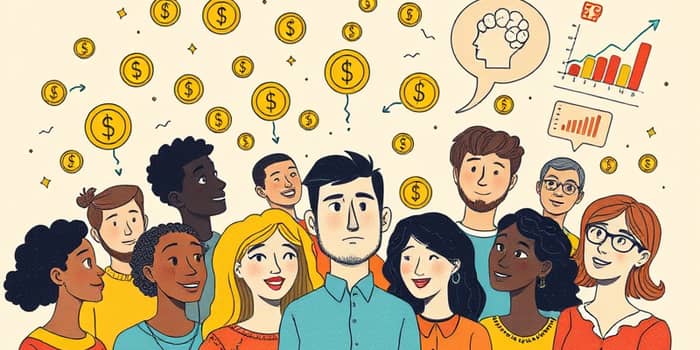Financial decisions influence every aspect of our lives, yet traditional theories often fall short in explaining real-world choices. By illuminating the hidden factors guiding our money habits, behavioral economics offers a roadmap for smarter decisions and greater financial well-being.
What Is Behavioral Economics?
Behavioral economics merges psychology with economic theory to understand why people often behave irrationally with money, challenging the idea of perfectly rational actors. Rather than assuming flawless logic, it examines how cognitive biases, emotions, and heuristics distort our choices.
At its core, this field studies the blend of psychology and economics to reveal patterns that traditional frameworks overlook. By acknowledging factors like fear, regret, and social influence, it paints a richer picture of financial decision-making.
Key Concepts in Behavioral Economics
Several foundational ideas drive behavioral economics. Understanding these can help individuals and institutions design better strategies and policies.
- Cognitive biases: Systematic deviations from logic that shape judgments. Examples include anchoring bias (overreliance on initial information) and confirmation bias (seeking evidence that supports existing beliefs).
- Emotions in finance: Emotions such as fear, greed, and regret can trigger panic selling or reckless risk-taking, undermining long-term plans.
- Heuristics: Mental shortcuts like mental accounting, where people treat money differently based on its source (e.g., windfall gains vs. regular income).
- Self-control and present bias: The conflict between immediate gratification and future benefits often leads to under-saving or overspending.
- Social influence: People frequently follow the crowd—herd behavior can inflate asset bubbles or trigger sudden market sell-offs.
Each of these factors contributes to systematic errors in judgment that impact budgets, investments, and long-term planning.
Choice Architecture and Nudges
Choice architecture refers to the design of environments in which people make decisions. Subtle shifts in how options are presented can produce profound changes in behavior.
- Default options: Automatically enrolling employees in retirement plans typically boosts participation from 40% to over 90%.
- Framing effects: Presenting the same outcome as a gain ("You will retain $X") rather than a loss ("You will lose $Y") can shift risk preferences.
- Pre-commitment devices: Tools like automated transfers to savings accounts help people automate savings and investments and resist impulsive choices.
By harnessing the power of choice architecture, policymakers and financial institutions can encourage healthier financial behaviors without restricting freedom of choice.
Real-World Applications and Strategies
Translating theory into practice empowers individuals and organizations to make better decisions.
- Individual strategies: Reinforce budgets with apps that track spending, set round-up transfers to savings, and schedule automatic contributions to retirement accounts.
- Policy-level interventions: Implement opt-out enrollment for social benefits, design reminders for overdue payments, and simplify application processes to reduce choice overload.
- Corporate initiatives: Offer commitment savings accounts, provide clear and concise statements, and apply behavioral insights to customer journeys to promote prudent spending.
These tactics help embed long-term goals over short-term desires, making it easier to align daily actions with future aspirations.
Numbers That Reveal Behavior
Empirical evidence underscores the potency of behavioral insights in financial contexts:
These figures highlight how minor design changes can yield significant shifts in behavior, boosting participation and reducing procrastination.
Criticisms and Ethical Considerations
Despite its successes, behavioral economics faces scrutiny. Critics argue that overreliance on nudges may overlook structural issues like income inequality or lack of financial literacy.
Ethical questions also arise around transparency in behavioral interventions. Who decides which choices to nudge, and how can we ensure individuals remain in control of their decisions?
Balancing paternalistic guidance with respect for autonomy demands clear communication and ongoing evaluation of interventions’ effectiveness.
Looking Ahead: The Future of Behavioral Finance
As technology evolves, so do opportunities to apply behavioral insights. Fintech platforms increasingly incorporate personalized nudges based on spending patterns, tailored alerts to curb impulsive buys, and gamified saving challenges.
Researchers are advocating for tailored interventions for specific groups, recognizing that one-size-fits-all solutions may miss diverse needs across demographics and cultures.
By integrating ethical frameworks, expanding cross-disciplinary collaboration, and leveraging data responsibly, behavioral economics can continue to drive meaningful improvements in financial well-being.
Ultimately, understanding the invisible forces behind our monetary choices equips us to design better systems, policies, and personal habits that foster long-term stability and prosperity.
Whether you’re an individual striving for a healthier financial future or a policymaker seeking impactful reforms, the principles of behavioral economics offer a powerful toolkit for change.
References
- https://imarticus.org/blog/behavioral-economics-in-financial-decision-making/
- https://www.donnelly-boland.com/post/how-behavioral-economics-can-improve-your-financial-decision-making
- https://papers.ssrn.com/sol3/papers.cfm?abstract_id=3887605
- https://www.abacademies.org/articles/behavioral-finance-the-psychology-behind-financial-decisionmaking-16266.html
- https://www.themilazzogroup.com/blog/how-behavioral-economics-can-help-you-keep-new-years-financial-resolutions
- https://www.ssa.gov/policy/docs/ssb/v70n4/v70n4p1.html
- https://nimss.org/projects/view/mrp/outline/15376










